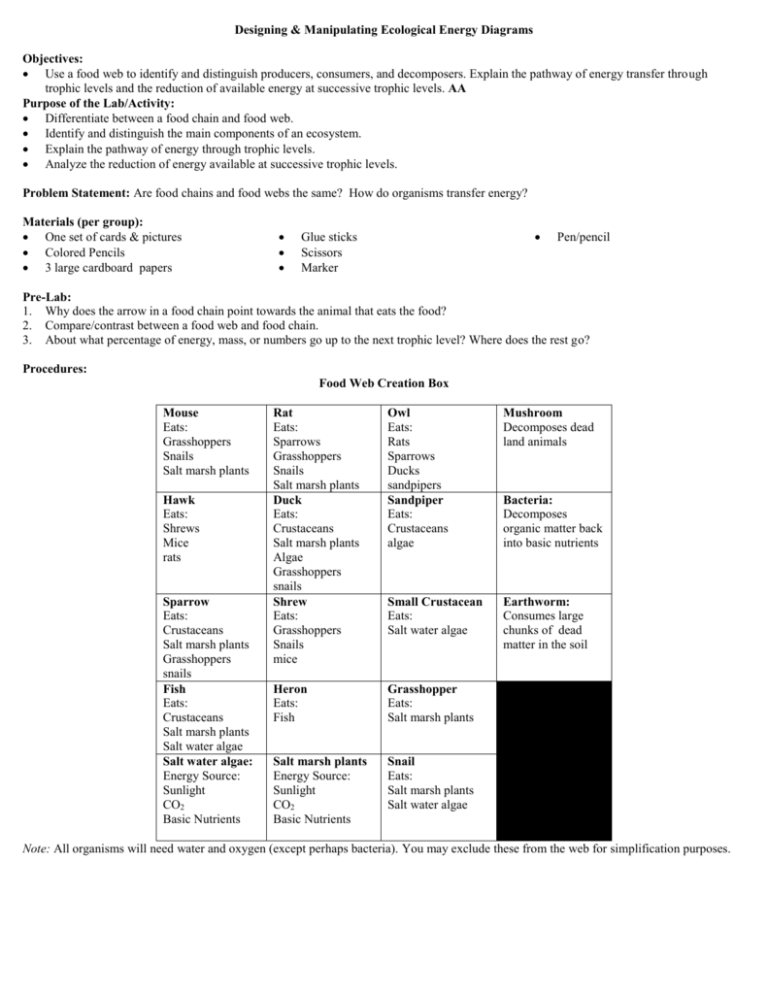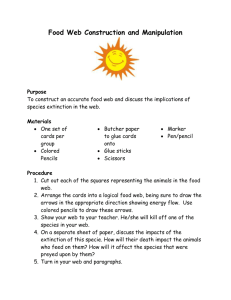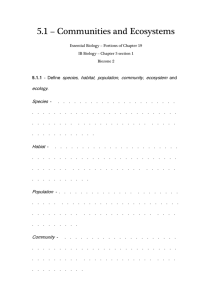Food Web Construction and Manipulation
advertisement

Designing & Manipulating Ecological Energy Diagrams Objectives: Use a food web to identify and distinguish producers, consumers, and decomposers. Explain the pathway of energy transfer through trophic levels and the reduction of available energy at successive trophic levels. AA Purpose of the Lab/Activity: Differentiate between a food chain and food web. Identify and distinguish the main components of an ecosystem. Explain the pathway of energy through trophic levels. Analyze the reduction of energy available at successive trophic levels. Problem Statement: Are food chains and food webs the same? How do organisms transfer energy? Materials (per group): One set of cards & pictures Colored Pencils 3 large cardboard papers Glue sticks Scissors Marker Pen/pencil Pre-Lab: 1. Why does the arrow in a food chain point towards the animal that eats the food? 2. Compare/contrast between a food web and food chain. 3. About what percentage of energy, mass, or numbers go up to the next trophic level? Where does the rest go? Procedures: Food Web Creation Box Mouse Eats: Grasshoppers Snails Salt marsh plants Hawk Eats: Shrews Mice rats Sparrow Eats: Crustaceans Salt marsh plants Grasshoppers snails Fish Eats: Crustaceans Salt marsh plants Salt water algae Salt water algae: Energy Source: Sunlight CO2 Basic Nutrients Rat Eats: Sparrows Grasshoppers Snails Salt marsh plants Duck Eats: Crustaceans Salt marsh plants Algae Grasshoppers snails Shrew Eats: Grasshoppers Snails mice Owl Eats: Rats Sparrows Ducks sandpipers Sandpiper Eats: Crustaceans algae Mushroom Decomposes dead land animals Small Crustacean Eats: Salt water algae Earthworm: Consumes large chunks of dead matter in the soil Heron Eats: Fish Grasshopper Eats: Salt marsh plants Salt marsh plants Energy Source: Sunlight CO2 Basic Nutrients Snail Eats: Salt marsh plants Salt water algae Bacteria: Decomposes organic matter back into basic nutrients Note: All organisms will need water and oxygen (except perhaps bacteria). You may exclude these from the web for simplification purposes. 1. 2. 3. 4. Cut out the pictures representing the animals in the food web Food Web: Using the table above as reference. Arrange the cards into a logical food web, being sure to draw the arrows (pencil) in the appropriate direction showing energy flow. Once you are sure of your design do the following steps: a. Use colored pencils to write animal names under the pictures. Names should be color coded as follows: Green = Producers Blue = Herbivore Yellow = Omnivores Red = Carnivore Black = Decomposers Orange = Detrivore Also underline any animals that are considered scavengers b. Use color pencil to color code arrows Green = Arrow represents link between basic nutrient and a producer, or energy exchange between abiotic factors and biotic factors Blue = Arrow represents primary consumption, or energy exchange between a producer and a consumer Yellow = Arrow represents secondary consumption, or energy exchange between a primary and a secondary consumer Orange = Arrow represents greater than secondary consumption (tertiary or higher), or energy exchanges between higher trophic levels Black = Arrow represents a nutrient recycling step taken by detrivore or decomposer Food Chain: Using the second set of pictures and the same color-coding as above (base it on information table and on the food web you designed), create a diagram that shows at least 6 different chains in the ecosystem. Use as many of the pictures as you can, but save 1 picture of each animal for the next part. If you run out of pictures (already used animal and want to use it again), try using a different chain or draw it again. Trophic Levels Through a Energy Pyramid: Using the third set of pictures, create a food pyramid with the animals. Remember to place all producers in the bottom level. On the next level, place primary consumers (eat only producers). On the third level, place any organism that eats primary consumers. On the fourth level, place any organisms that eat those, etc. Note: Some organisms are at different trophic levels depending on which chain you look at it. For the purpose of this activity. Place the animal on the highest level it occupies. Discussion Questions: 1. What does the suffix “troph” mean? 2. What do you think a trophic level is? 3. Give an example of an animal that occupies different trophic levels depending on which food chain you look at. Write down the chains to illustrate your point. 4. Explain what would happen if all of the primary consumers became extinct. 5. Explain why food webs with many species (biodiverse) are more resilient than those with few species. 6. Where is there more energy available at the bottom or at the top of the food chain / energy pyramid? Explain your answer 7. Based on your knowledge about energy levels in the each trophic level, explain why earth could support many more people if we ate at a lower trophic level. 8. Large predatory fish usually are found at the 3 rd or 4th trophic level of an energy pyramid. a. Why do you think organisms at higher trophic levels tend to be larger (There are exceptions) b. Considering trophic energy/biomass limitations (see question 8), what does this mean in terms of how much they need to eat in comparison to animals at lower levels? c. Speculate about why there are usually few large predators (compared to smaller) 9. List 2 benefits and 2 drawbacks of society eating at a lower trophic level








